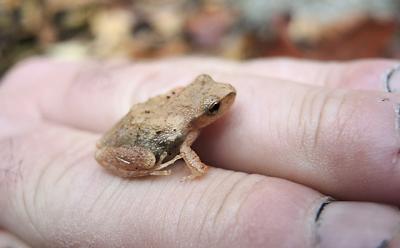Nature Notes: Fall Peepers?

The rain and wind of last Wednesday didn’t spoil the fall foliage after all. As of Monday, the oaks in my yard still had three-quarters of their leaves and were more than 50-percent green. Is it a sign of global warming that leaves take longer and longer each year to turn or is it just some enigma that won’t easily be explained and predictable for some time?
The turn of the leaves is late, and so, too, is the hibernation of the spring peepers and other local frogs. On Sunday, the four new interns from East Hampton High School who continued the multiyear study of Montauk’s Big Reed Pond environs accompanied by their Third House Nature Center tutors ran into a bunch of them. Before they saw a few on the forest floor as they walked along, they heard many more peeping away.
We call them “spring” peepers because they peep the most in spring when they begin breeding at the time of the vernal equinox. In California near my old Santa Barbara residence, the tree frogs in the same genus, Pseudacris, and almost identical to our local ones in appearance, could be called “fall peepers” because they peep in the fall around the beginning of the rainy season. They’re called California tree frogs.
Ours are moving underground at this time, although a little later than usual, and the males peep now and then during the process. Is it a rallying cry? “We’re going under now, see you next spring, don’t forget.” “Let’s hope next March and April is wetter and we can spawn a big crop of larvae and tadpoles to make up for this year’s low turnout.” As soon as there is water available after February, the spring peeper, which can stand freezing temperatures in the low 20s, gets going. It is not deterred by cold snaps.
Birds migrate to the tropics and near-tropics to find food in the winter. Amphibians are cold-blooded, don’t fly, and eat mostly insects. Why stay above ground, insect-less, and suffer the cold in November, December, January, and February when you can be hibernating away underground?
Yes, it was a bad year for the early-breeding amphibians. Most of the ephemeral ponds in which they breed had very little water in them or none at all. The gray tree frog, the spring peeper’s slightly bigger brother, did a little better, and bred on and off into late July, whenever it rained.
All of our salamanders save one also need spring water in which to lay their eggs. They must have taken a hit as well. The South Fork salamander that doesn’t need water, the leadback — a morph of the red-backed salamander — should have done well, but, try as I might, I couldn’t find a single one all spring and summer long. In the year before, I only came across one,in Montauk off Flamingo Road.
This species, Plethodon cinereus, occurs throughout most of the country and is reputed to be the most common of allAmerican salamander species. But something is happening to dispute this reputation on eastern Long Island. It lives in the leaf litter and under fallen logs and rocks. You can often judge the success of a species by the number of eggs it lays when breeding.
Most frogs and salamanders lay hundreds, the leadback lays eight on average. Moreover, it’s our only lungless salamander; it breathes through it mucousy skin, which must stay moist to enable oxygen exchange, although the babies at hatching have tiny gills, the evolutionary trademark of almost all amphibians. (I should point out that another forest-floor creature, the box turtle, lays about the same number of eggs and it too is in serious decline locally. Its biggest predator is of the four-wheeled variety.)
It’s been dry these last few years, but not dry enough to explain the virtual disappearance of the leadback salamander from most South Fork habitats. And it probably isn’t the dreaded chytrid fungus that has been decimating amphibian populations worldwide over the past two decades. Plethodon cinereus has sympatric bacteria that produce violacein, a substance that renders the chytrid fungus harmless.
I’m beginning to think that the rise of another species in the area is coincidental with the plight of the leadback salamander. That species is a heavy forager of the leaf litter creatures and eats anything that’s creepycrawly in addition to vegetation andberries — the wild turkey, gone from most of Long Island by the beginning of the 19th century, but now making a spectacular comeback after being successfully reintroduced by the New York State Department of Environmental Conservation in the first years of the 1990s.
It remains to be seen. I wonder how Plethodon cinereus is doing on Gardiner’s Island? They’ve had turkeys running wild over there since the early 1960s. But ever since the late Robert Gardiner died it’s been hard to visit the island during the salamander’s active months, March through October.
Larry Penny can be reached via email at [email protected].
